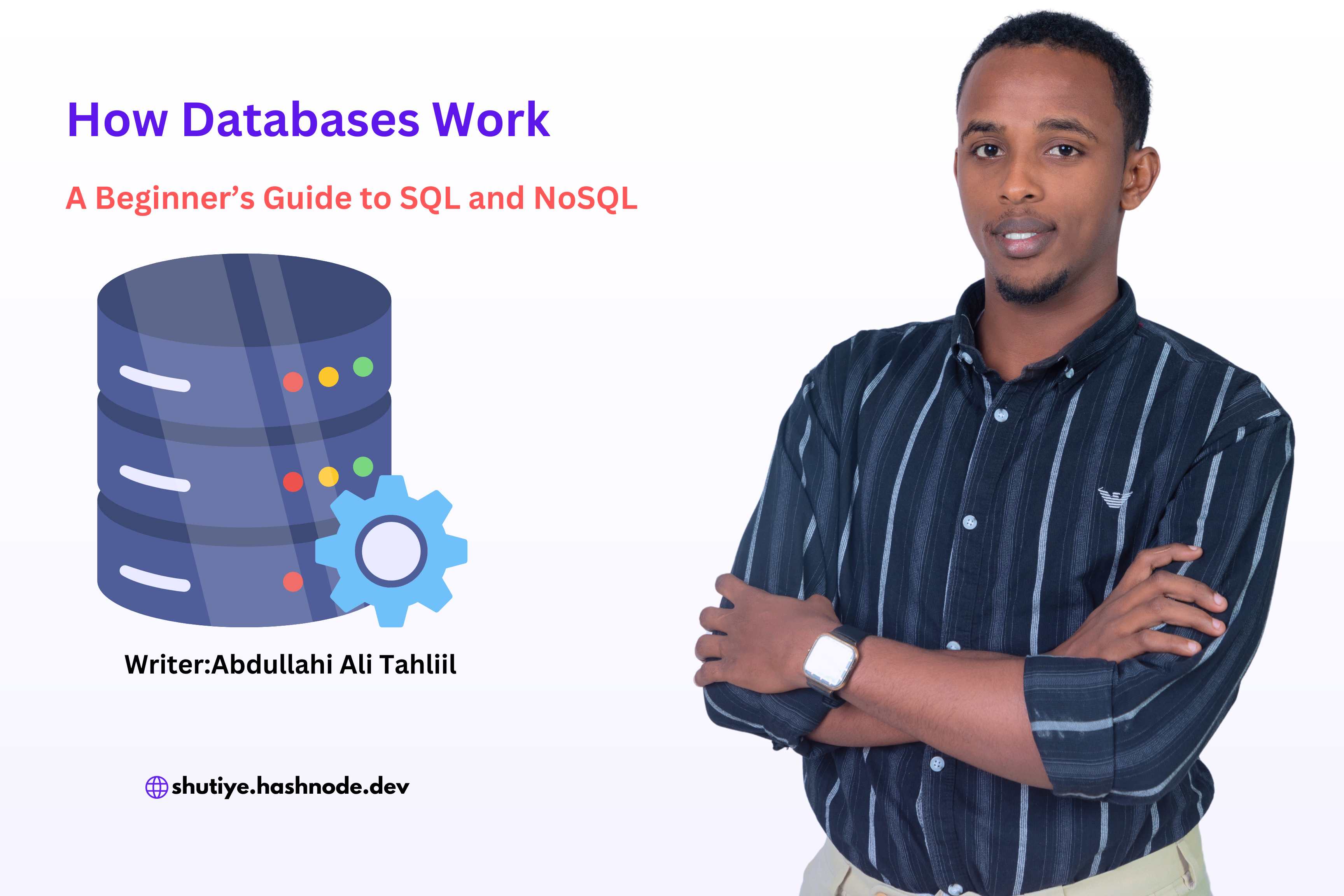How Databases Work
 Abdullahi Tahliil
Abdullahi Tahliil
Introduction
Databases are at the heart of modern applications, storing and managing the vast amounts of data that power websites, mobile apps, and enterprise systems. Whether you’re a beginner developer or just curious about how data is stored, understanding databases is crucial. In this post, we’ll explore how databases work, the differences between SQL and NoSQL databases, and how to choose the right one for your needs.
What is a Database?
A database is a structured collection of data that allows users to store, retrieve, manage, and manipulate information efficiently. Databases are used in almost every application, from small websites to large-scale distributed systems.
Types of Databases
There are two primary types of databases:
SQL (Relational) Databases: Structured and based on tables with predefined schemas.
NoSQL (Non-Relational) Databases: Flexible, schema-less, and designed to handle diverse data types.
Let’s break them down further.
Understanding SQL Databases
What is SQL?
SQL (Structured Query Language) is a language used to interact with relational databases. These databases organize data into tables with predefined relationships between them.
Features of SQL Databases:
Structured Schema: Data is stored in tables with fixed columns and data types.
ACID Compliance: Ensures data consistency through Atomicity, Consistency, Isolation, and Durability.
Powerful Queries: SQL allows complex queries with JOINs, aggregations, and filtering.
Popular SQL Databases:
MySQL
PostgreSQL
Microsoft SQL Server
Oracle Database
SQLite
When to Use SQL Databases?
SQL databases are best when:
Your data has a structured format.
You need complex queries and relationships between data.
Data consistency and integrity are critical (e.g., banking systems)
Understanding NoSQL Databases
What is NoSQL?
NoSQL databases offer a more flexible approach to storing and managing data. They are designed for high performance, scalability, and handling unstructured or semi-structured data.
Types of NoSQL Databases:
Document Databases: Store data in JSON-like documents (e.g., MongoDB, CouchDB).
Key-Value Stores: Simple key-value pairs for fast lookups (e.g., Redis, DynamoDB).
Column-Family Stores: Store data in columns instead of rows (e.g., Cassandra, HBase).
Graph Databases: Store relationships between data nodes (e.g., Neo4j, ArangoDB).
Features of NoSQL Databases:
Schema-less: No predefined structure, allowing flexible data storage.
Horizontal Scalability: Easily handles massive amounts of data by distributing across multiple servers.
High Performance: Optimized for speed and real-time applications.
When to Use NoSQL Databases?
NoSQL databases are ideal when:
You need to handle large-scale, unstructured data (e.g., social media, IoT, big data).
Scalability and fast performance are top priorities.
Your data model is dynamic and evolves over time.
SQL vs. NoSQL: Key Differences
| Feature | SQL Databases | NoSQL Databases |
| Structure | Structured tables with predefined schema | Flexible, schema-less |
| Scalability | Vertical scaling (more CPU/RAM) | Horizontal scaling (more servers) |
| Data Type | Relational (structured) | Unstructured, semi-structured |
| Transactions | ACID compliance | Eventual consistency |
| Performance | Optimized for complex queries | Optimized for high-speed, large-scale applications |
| Use Case | Financial systems, enterprise applications | Real-time analytics, big data, social networks |
Choosing the Right Database
Questions to Ask:
What type of data are you handling? (Structured vs. unstructured)
How important is consistency? (ACID vs. eventual consistency)
Do you need high scalability? (Vertical vs. horizontal scaling)
What are your performance needs? (Complex queries vs. speed and flexibility)
If your project needs structured data with strong consistency, go with SQL. If you need flexibility, scalability, and high performance for unstructured data, choose NoSQL.
Conclusion
Databases are a crucial component of software development, and understanding the differences between SQL and NoSQL helps you make informed decisions when building applications. SQL databases offer structured data management and consistency, while NoSQL databases provide flexibility and scalability. Choose wisely based on your project’s requirements!
What’s Next?
If you're new to SQL, start by learning basic CRUD operations in MySQL or PostgreSQL.
If you're interested in NoSQL, try setting up a MongoDB database and explore document-based storage.
Subscribe to my newsletter
Read articles from Abdullahi Tahliil directly inside your inbox. Subscribe to the newsletter, and don't miss out.
Written by
